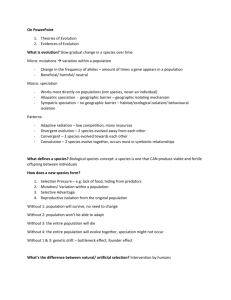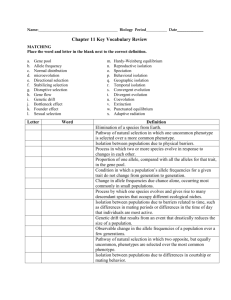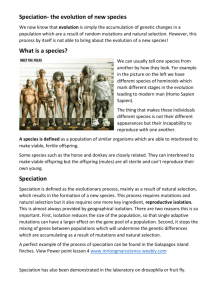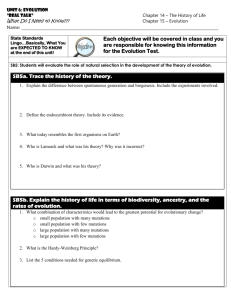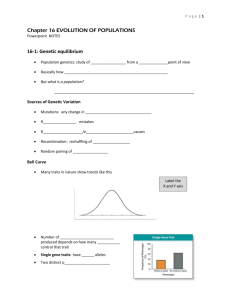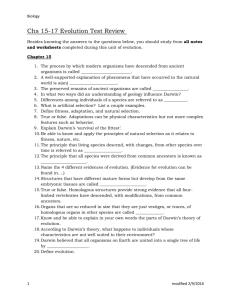Evolution Test-DO NOT WRITE ON THIS THE TEST According to
advertisement
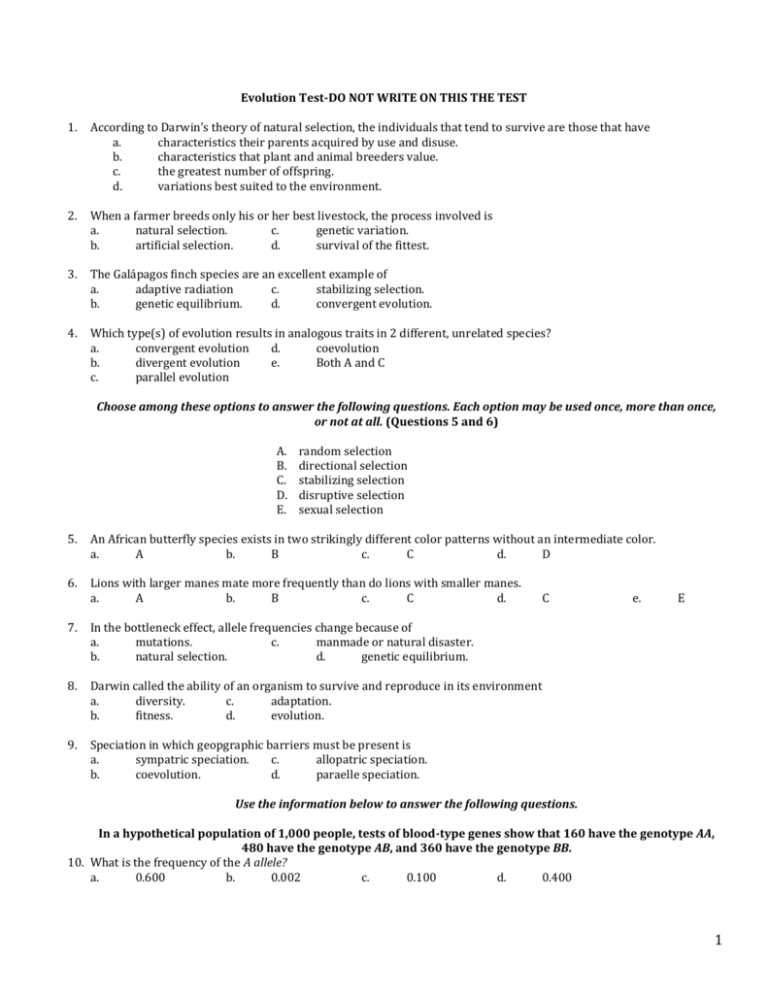
Evolution Test-DO NOT WRITE ON THIS THE TEST 1. According to Darwin’s theory of natural selection, the individuals that tend to survive are those that have a. characteristics their parents acquired by use and disuse. b. characteristics that plant and animal breeders value. c. the greatest number of offspring. d. variations best suited to the environment. 2. When a farmer breeds only his or her best livestock, the process involved is a. natural selection. c. genetic variation. b. artificial selection. d. survival of the fittest. 3. The Galápagos finch species are an excellent example of a. adaptive radiation c. stabilizing selection. b. genetic equilibrium. d. convergent evolution. 4. Which type(s) of evolution results in analogous traits in 2 different, unrelated species? a. convergent evolution d. coevolution b. divergent evolution e. Both A and C c. parallel evolution Choose among these options to answer the following questions. Each option may be used once, more than once, or not at all. (Questions 5 and 6) A. B. C. D. E. random selection directional selection stabilizing selection disruptive selection sexual selection 5. An African butterfly species exists in two strikingly different color patterns without an intermediate color. a. A b. B c. C d. D 6. Lions with larger manes mate more frequently than do lions with smaller manes. a. A b. B c. C d. C 7. In the bottleneck effect, allele frequencies change because of a. mutations. c. manmade or natural disaster. b. natural selection. d. genetic equilibrium. 8. Darwin called the ability of an organism to survive and reproduce in its environment a. diversity. c. adaptation. b. fitness. d. evolution. 9. Speciation in which geopgraphic barriers must be present is a. sympatric speciation. c. allopatric speciation. b. coevolution. d. paraelle speciation. e. E Use the information below to answer the following questions. In a hypothetical population of 1,000 people, tests of blood-type genes show that 160 have the genotype AA, 480 have the genotype AB, and 360 have the genotype BB. 10. What is the frequency of the A allele? a. 0.600 b. 0.002 c. 0.100 d. 0.400 1 11. What is the frequency of the B allele? a. 0.600 c. 0.100 b. 0.002 d. 0.400 12. Sharks, dolphins, and penguins all have streamlined bodies and appendages that enable them to move through water. These similarities are the result of a. coevolution. c. parallel evolution. b. convergent evolution. d. adaptive radiation. 13. The number and location of bones of many fossil vertebrates are similar to those in living vertebrates. Most biologists would probably explain this fact on the basis of a. the needs of the organisms. c. the struggle for existence. b. a common ancestor. d. the inheritance of acquired traits. 14. One scientist who attempted to explain how rock layers form and gradually change over time was (gradualism) a. Thomas Malthus. c. Georges Cuvier b. James Hutton. d. Jean-Baptiste Lamarck. 15. The genetic equilibrium of a population can be disturbed by each of the following EXCEPT a. nonrandom mating. b. movement into and out of the population. c. a large population size. d. mutations. 16. If suppose there was a virus that only affected people below a certain height, the virus would select for people with higher heights and pass those genes to the next generation. What type of selection am I? a. directional selection c. stabilizing selection b. disruptive selection d. genetic drift 17. When individuals with an heterozygous phenotype of a trait have the highest fitness, the result is a. Hardy Weinberg equilibrium. c. directional selection. b. disruptive selection. d. stabilizing selection. 18. Lamarck’s theory of evolution includes the concept that new organs in a species appear as a result of a. continual increases in population size. b. the actions of organisms as they use or fail to use body structures. c. an unchanging local environment. d. the natural variations already present within the population of organisms. 19. What type of evolution produced the three forelimbs in Figure 10.3? a. Convergent evolution b. Divergent evolution c. Vestigial evolution d. Homologous evolution 20. In a Hardy-Weinberg population with two alleles, A and a, that are in equilibrium, the frequency of allele a is 0.7. What is the percentage of the population that is heterozygous for this allele? a. 30 b. 9 c. 21 d. 42 2 21. Which of the following statements best explains why this picture of the bones of four different animals supports the theory of evolution? a. b. c. d. The bones are analogous; they represent variations on a structural theme that was present in a common ancestor. The bones are homologous; they represent variation on a structural theme that was present in a common ancestor. Because the animals are all mammals, they share a recent common ancestor. Although these underlying bones exhibit differences structurally, they all have the same function. 22. Which of the following statements best describes adaptive radiation? a. Many different species of finch on the Galapagos Islands today diverged from a single ancestral species that each specialized to fill a different ecological niche. b. Both the whale and the shark have a similar streamlined appearance even though they are not closely related. c. One population of antelope evolves into two separate species because they are separated by a wide river for millions of years. d. It is any change in a gene pool due to chance. 23. In a population, the sum of the relative frequencies of all alleles for a particular trait is a. equal to 100 percent. b. equal to the number of alleles for the trait. c. constantly changing. d. dependent on the number of alleles. 24. The mating of a horse and a donkey produces a mule. This is an example of a reproduction barrier called _________. a. b. mechanical isolation. gametic isolation. c. reduced hybrid viability. d. reduced hybrid fertility. 25. A population is in Hardy-Weinberg equilibrium. The frequency of a recessive phenotype appears in 14% of the population. Which of the following statements is correct about what frequency of the allele will be in 500 years and the correct reason for it? a. 1 The allele will decrease in frequency because it is a mutation and mutations are generally disadvantageous. b. It will increase in frequency because 500 years is a long time for a population to stay static. c. It will occur at the same frequency because 500 years is a long time for a population to stay static. d. It will occur at the same frequency because the population is at Hardy-Weinberg equilibrium. 26. An adaptation is an inherited characteristic that can be 3 a. physical or behavioral. b. physical or geographical. c. acquired during the organism’s lifetime. d. the result of artificial selection. e. the result of lethal mutations 27. In peas, a gene controls flower color such that R = purple and r = white. In an isolated pea patch, there are 36 purple flowers and 64 white flowers. Assuming Hardy-Weinberg equilibrium, what is the value of q for this population? a. 0.60 b. 0.64 c. 0.75 d. 0.80 28. The process by which two species, for example, a flower and a pollinating insect, evolve in response to each other is called a. convergent evolution. c. coevolution. b. adaptive radiation. d. punctuated equilibrium. 29. Which statement is true about anagenesis? a. Determining where and how basic features are arranged. b. Presence of extra sets of chromosomes due to accidents during cell division. c. Transforming one species into another. d. Splitting the gene pool, giving rise to one or more new species. 30. In humans, the pelvis and the femur, or thighbone, are involved in walking. In whales, the pelvis and femur are shown below. In whales, these structures are an example of ______. a. b. c. unaltered fossils. vestigial structures. analogous structures. e. d. natural variation. homologous structures. 31. Through time, the movement of people on Earth has steadily increased. This has altered the course of human evolution by increasing a. nonrandom reproduction. d. gradual equilibrium. b. geographic isolation. e. gene flow. c. genetic drift. 32. The following important concepts of population genetics are due to random events or chance except a. mutation. d. natural selection. b. the bottleneck effect. e. sexual recombination. c. the founder effect. 33. Natural selection acts directly on a. alleles. b. populations. c. phenotypes. d. genotypes 34. Which of the following pairs are homologous? 4 a. b. bat wing and whale flipper owl wing and hornet wing c. d. porcupine quill and cactus spine bat forelimb and bird wing 35. Evolution may be defined as changes over time in the allele frequency of a population or species. All of the following are examples of evolutionary processes EXCEPT a. artificial selection in domestic dogs. b. Genetic drift of an allele frequency c. Mutations that decrease reproductive fitness d. Natural Selection between different colors of insects e. populations in Hardy-Weinberg equilibrium 36. When Darwin returned from the voyage of the Beagle, he a. immediately published his ideas about evolution. b. realized his ideas about evolution were wrong. c. wrote about his ideas but waited many years to publish them. d. copied the evolutionary theory of Wallace. 37. Which statement about gene pools is typically true? a. They contain two or more alleles for each gene. b. They contain only dominant alleles. c. They belong to two or more interbreeding species. d. The relative frequencies of the alleles never change. 38. The separation of populations by barriers such as rivers, mountains, or bodies of water is called a. temporal isolation. c. behavioral isolation. b. geographic isolation. d. mechanical isolation. Figure 16–3 39. In Figure 16–3, what type of evolution is most likely occuring? a. b. c. Convergent evolution Divergent evolution Coevolution d. e. Adaptive radiation Both B and D 40. Suppose that researchers suspected that two groups shown in Figure 16–3 were actually a single species. How might the researchers test that hypothesis? 5 a. Mate a female from one group with a male of the other group and see if viable, fertile offspring are created. b. Observe a female from one group and a male of the other group. If both organisms have the same fitness then they are the same species. c. Play the mating song from the common finch ancestor living on the mainland and observe if both groups respond to this song in the same way. d. It is impossible to test a hypothesis like this. 41. What situation might develop in a population having some plants whose flowers open at midday and other plants whose flowers open late in the day? a. behavioral isolation c. temporal isolation b. geographic isolation d. mechanical isolation 42. When lions prey on a herd of antelope, some antelope are killed and some escape. Which part of Darwin’s concept of natural selection might be used to describe this situation? a. acquired characteristics c. survival of the fittest b. reproductive isolation d. descent with modification 43. During the voyage on the Beagle, Charles Darwin made many observations a. in England. c. on the Galápagos Islands. b. in North America. d. in Asia. 44. Peppered moths living in Britain prior to the Industrial revolution were almost all light in color; a few dark moths were occasionally noted. The moths fly by night and rest during the day on lichen covered tree trunks (which were also a light color). During the Industrial Revolution soot began to blacken the trees. Which moths would display a favorable adaptation after the Industrial Revolution? a. Light colored moths b. Dark colored moths c. Medium colored moths d. No coloring would be favorable 45. What is speciation? a. combining of two species to form one with different traits b. isolation that affects mating behavior c. timing of mating that prevents normal sexual selection d. divergence of two or more species from an existing one 46. 2 mice never encounter each other because they live in two different places without being isolated by any geographical barriers. This is an example of: a. Allopatric Speciation b. Sympatric Speciation c. Mechanical Speciation d. Gametic Speciation 47. A genetic isolation WITHOUT a geographical barrier; but have other barriers that isolate the population in the same area, this is called: a. Geographic Isolation b. Reproductive Isolation c. Random Selection d. Allopatric Isolation 48. A difference of chemical scents between two populations that use chemical communication is an example of what kind of isolation? a. temporal b. behavioral 6 c. mechanical d. disruptive 49. Which species from Figure 10.4 has the most amino acids that are different from those of humans? a. Mouse b. Frog c. Chicken d. Lamprey 50. Figure 10.4 - Which species has the most amino acids in common with humans? a. Mouse b. Frog c. Rhesus Monkey d. Lamprey 51. An earthquake causes an ocean channel to open up on an island where a low area previously existed. The island's lizard population is now separated on the two parts of the island, providing an example of a. Allopatric speciation b. Sympatric speciation c. Disruptive selection. d. Convergent evolution 52. Macroevolution can be defined as: a. Small changes in gene frequency b. Gene flow in through immigration c. Origin of different species d. A population moves to a new location and they do not represent all the possible alleles 53. What is the study of the distribution of organisms around the world? a. paleontology b. geography c. geology d. biogeography 7 54. Fossil evidence shows that structures considered vestigial in living organisms a. are not found in ancient organisms. b. have always been vestigial. c. were useful to their ancestors. d. do not fill gaps in the fossil record. 55. What is suggested by the similarity of early embryos of different species of vertebrates? a. no evolutionary relationship between the groups b. recent common ancestry c. similar environments in the past d. evolution from a distant common ancestor Figure 5-2 56. What type of selection is demonstrated by the data in this graph in Figure 5-2? a. Directional selection b. Stabilizing selection c. Disruptive selection d. Coevolution 57. What are sources of genetic variation? a. Genetic combination made during meiosis b. Viable errors made in replication c. Mutations caused by environmental factors d. All of the above 58. What best describes that there is a phenotypic difference between males and females of the same species? e. Sexual dimorphism f. Sexual selection g. Intersexual selection h. Intrasexual selection 59. If the a hybrid between two crops is very weak and won’t live long, what is this an example of? a. Prezygotic Isolation b. Reduced Hybrid Fertility c. Reduced Hybrid Viability d. Postzygotic Isolation e. Both C and D 60. Polyploidy can cause evolution in some plant species. What is polyploidy? a. presence of extra sets of chromosomes due to accidents during mutations b. presence of extra sets of chromosomes due to accidents during meiosis c. deletion of sets of chromosomes due to accidents during mutations d. deletion of sets of chromosomes due to accidents during meiosis 8
